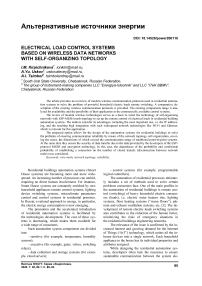Electrical load control systems based on wireless data networks with self-organizing topology
Автор: Kirpichnikova I.M., Uskov A.Yu., Tsimbol A.I.
Журнал: Вестник Южно-Уральского государственного университета. Серия: Энергетика @vestnik-susu-power
Рубрика: Альтернативные источники энергии
Статья в выпуске: 1 т.20, 2020 года.
Бесплатный доступ
The article provides an overview of modern wireless communication protocols used in residential automation systems to solve the problem of powerful household electric loads remote switching. A comparative description of the existing wireless communication protocols is provided. The existing components range is analysed for availability and the possibility of their application in the commercially available control systems. The review of modern wireless technologies serves as a basis to select the technology of self-organizing networks with ESP-MESH mesh topology to set up the remote control of electrical loads in residential building automation systems. The authors consider its advantages, including the most important one, i.e. the IP addressing, and the resulting high integration with such widespread network technologies like Wi-Fi and Ethernet, which is relevant for this application. The proposed option allows for the design of the automation systems for residential buildings to solve the problems of ensuring communication reliability by means of the network topology self-organization, covering the zones, the dimensions of which exceed the communication range of traditional point-to-point systems. At the same time they ensure the security of data transfer due to the data provided by the developers of the ESP-protocol MESH and encryption technology. In this case, the dependence of the probability and conditional probability of establishing a connection on the number of closed transits (disconnection between network nodes) was considered.
Wire mesh, network topology, reliability
Короткий адрес: https://sciup.org/147234045
IDR: 147234045 | УДК: 621.316 | DOI: 10.14529/power200110
Текст научной статьи Electrical load control systems based on wireless data networks with self-organizing topology
Residential buildings automation systems (Smart House systems) are becoming more and more widespread. An increasing number of processes can unfold, requiring no direct human involvement. For instance, Smart House systems are constantly enriched by new household appliances remote control systems, lighting device switching systems, microclimate parameters control and control systems in residential premises. In Russia, a rational approach to energy, in particular, the electric energy consumption is now emerging.
The promotion and the accelerated introduction of residential automation systems is facilitated by the technologies development. The cost of these systems is decreasing, which makes them available for a wide range of consumers.
Such automation system components are divided into:
-
– sensitive (for example, temperature, humidity sensors);
-
– executive (for example, gates, valves, switching relays);
-
– data collection and storage systems (for example, cloud servers);
-
– control systems (for example, programmable logical controllers).
The automation of residential processes ultimately includes a set of methods used to solve certain problems consumers face. One of the main profiles in the automation of residential buildings is remote control (switching) of heavy household electric consumers (loads), i.e. electric water heaters tins, lighting systems, floor heating systems (“warm floors”), plenum and exhaust ventilation systems, etc. [1]. The development of remote electric loads switching systems also contributes to the reduction of the human factor, minimizing the risks of emergency situations in the residential buildings engineering networks.
The relevance of the issue is confirmed by the increased interest and growing demand for the Internet of Things (“IoT”) technology, which unites all the inhouse devices into a single network. Each household appliance in the house has its individual properties and attributes assigned.
While designing the residential automation systems, developers often lack the resources to ensure sustainable communication between the system ele- ments. This problem may arise in large spaces or when the coupling elements are selected incorrectly. Thus the design of automation systems must first and foremost ensure the reliable and stable communication between the system parts to maintain their operational communication with the control device. There are two approaches to this task, which will be hereinafter considered separately.
The first approach is to link all the residential automation system elements with wired communic a tion lines. In this case the communication lines and the automation system elements are laid down during the residential premises project design. The commun i cations to the controls and sensors are laid along the load- bearing structures, being further covered with finishing materials. This makes any later changes to the e xisting automation system quite complicated [2].
The advantage of this solution is the high reliabi lity of the communication channel and the ease of implementation. The disadvantage lies in the limit a tions. If any upgrades or functional expansions are req uired sometime in the future, it will be necessary to dismantle the existing system and install the new components change the communication network stru c ture and content. At the same time, the system u p grade cost may be excessively high. In addition, this approach does not provide for the system flexibility and does not meet the existing level of communication technologies development.
The second approach features wireless communication networks, such as Wi-Fi or Bluetooth. It provides for a more flexible system, which will allow for a quick configuration of the automation system elements network. The main issue associated with this approach is the limited signal coverage (the network coverage area). The maximum range of a standard Wi-Fi router is 200 meters at best, and it may be further limited by the obstacles. In the real environment the signal will be distorted by the signals of other devices operating at the same frequency and weakened by different structural elements of buildings as well as the structures consisting of heterogeneous materials that have different capacity. When operating under difficult conditions of the external electromagnetic environment, the signal coverage can be reduced to 20 meters or less. Fig. 1 presents a graph demonstrating the attenuation of the Wi-Fi signal depending on the distance between the receiver and the transmitter [3].
Solving this problem requires an increase in the number of Wi-Fi access points to provide a full wireless network coverage in the required premises. Similar problems with Bluetooth technology are caused by the small coverage radius (10–20 meters). Therefore, there is a need for a solution that combines link reliability and flexibility to reconfigure the system to meet new challenges.
Globally there exist several residential buildings automation networks organization protocols, i.e. ZigBee, Z-Wave, Thread, Bluetooth Low Energy, and ESP-MESH, which will be further reviewed individually.
ZigBee is a radio communications protocol approved by the ZigBee Alliance in 2004. Data transmission is described by IEEE 802.15.4 [4]. The ZigBee protocol was designed to securely transfer data between the devices operating from a stand-alone power supply at low data rates.
The ZigBee standard operates at 868 MHz, 915 MHz, and 2.4 GHz bands. Operating at 2.4 GHz has the highest link throughput and immunity. Each band is divided into 16 frequency channels in 5 MHz increments. The maximum data rate is 250 kbps, including overhead information. The average bandwidth of the communication channel is in the range of 5 to 40 kbps and depends on the network load and the number of relays. The ZigBee supports Mesh Topology (MESH).
The MESH network is a network with the decentralized management, in which wireless devices unite the numerous connections forming cellular to- dBm
10"1
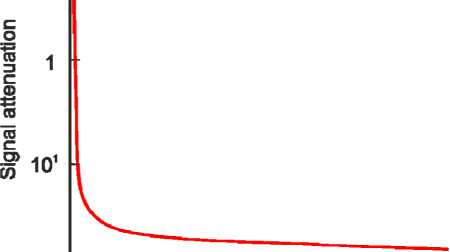
1Q2 --------- 1---------1---------1---------]--------- l^
0 2 4 6 8 10 m
Distance between receiverand transmitter
Fig. 1. Wi-Fi signal attenuation depending on the distance
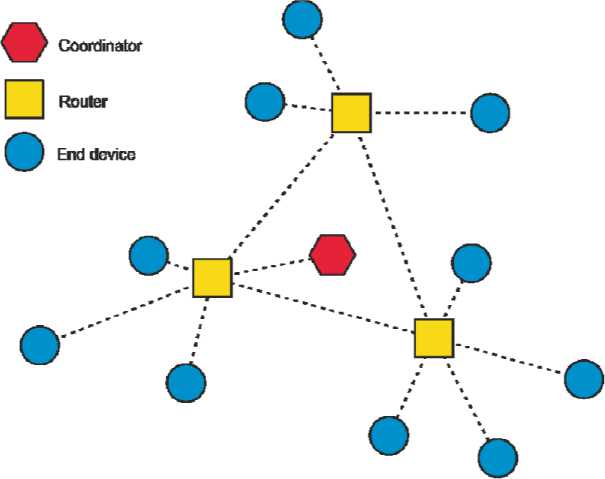
Fig. 2. ZigBee network routing Diagram
pology [5]. This network topology allows commun i cating with any device directly or through intermed i ate network nodes. The MESH network operati on al gorithm is based on finding the shortest path between the nodes. The message is translated from one device to another until it reaches the recipient.
A distinctive feature of MESH network is self organization, which allows solving several problems simultaneously, i.e.
-
– expansion of dense information covering zones;
-
– use of wireless communication channels;
-
– network resistance to the possible shutdown of a knots.
The standard ZigBee defines four types of nodes: end device, coordinator, router and sleeping device.
The endpoints are in power saving mode. This type of node uses a stand- alone power supply. This type of node includes sensors, switches, or actuator controllers.
The coordin ator is the main device of the ne t work. It forms a network, sets a security policy, and sets settings when you add a device to the network.
Routers route data packets in the network and are therefore ready for transmission at any time. This type of node ra rely works in low power mode. In building automation systems, it is advisable to use Smart Sockets as routers, lighting systems that are provided with constant power from the network.
The advantage of the ZigBe e standard is its ope ration with devices with low power consumption and fast response. Most of the network devices are in sleep mode with about 15 milliseconds being spent to restore them to the functional mode. Fig . 2 shows the routing diagram of the ZigBee network.
The disadvantage of this technology is the need to install additional equipment (coordinator connecting gateway for internet access) to communicate with external IP-network, as well as low data rate, which limits the transmission of, for example, video signal.
Z-Wave is a wireless communication technology with low power consumption by the network elements. The operating frequency range of Z-Wave is up to 1 GHz. The protocol transmits simple control commands with minimal delays. This interface operates on a channel below Wi-Fi networks to reduce the interference with control channels. Z-Wave is in many ways similar to ZigBee, the main difference is standardization. All Z-Wave devices must be based on Sigma Designs, which in turn ensures the compatibility of components with each other. The interface's disadvantages include a small amount of available software, but it is guaranteed to be compatible with any Z-Wave hardware [6].
Thread is a low-power wireless network protocol based on Internet Protocol (IP). This technology combines devices into a single infrastructure that has access to the LAN / WAN through a boundary router that converts 802.15.4 to an IP interface.
Thread integrates the benefits of IP networks (such as Wi-Fi) with wide-area Internet access and mesh-enabled networks.
The technology uses the Physical Interface Layer (PHY) and the IEEE 802.15.4 Medium Access Layer (MAC). Data transmission occurs in the 2.4 GHz frequency band with a bandwidth of up to 250 kbps. Thread supports the 6LoWPAN over Low IPv6 Wireless Personal Area Networks standard and specializes in data transfer between low-power devices.
There are only two types of devices in a Thread network, a router and an end node.
The router is a node that supports mesh network topology (search for optimal routes, relay messages,
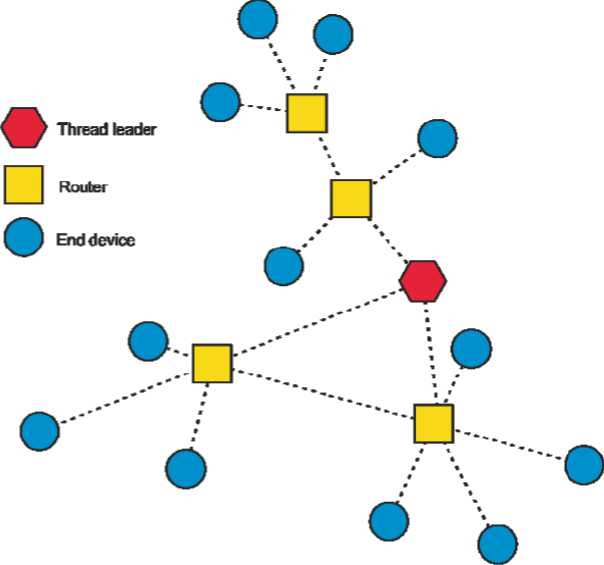
Fig. 3. Example of Thread network construction
and so on). There is a “leader” router, which organizes the network and performs additional tasks of routers and addresses appointment.
The information stored by the “leader” is dupl icated in the ro uters. If the network organizer fails, a new “leader” is assigned according to the rule “one network – one leader”.
End nodes cannot perform routing -related opera tions. All communication is carried out through “pa rent” nodes – routers.
A disadvantage of t his technology, like with ZigBee- based networks, is the need to install add ition al equipment (edge router) to communicate with an external IP network and a low data rate.
An example of Thread networking is shown in Fig. 3.
Bluetooth is one of the first interfaces to organize a wireless network within a 10 to 20 meter range at the 2.4 GHz frequencies. Residential buildings automation is a promising direction for the Bluetooth technology development. The BLE (Bluetooth Low Energy) protocol has been developed for these purposes – one of its applications is in the devices with autonomous power supply and the medium data rate of up to 1 Mbps. The data transfer in BLE technology is described in the IEEE 802.15.1 standard [7].
Bluetooth supports point-to-point and point-to-multipoint network connections [8]. If two or more devices use the same channel, they form a piconet. Cooperating piconets form a distributed network. Fig. 4 presents the organization of a Bluetooth inter-
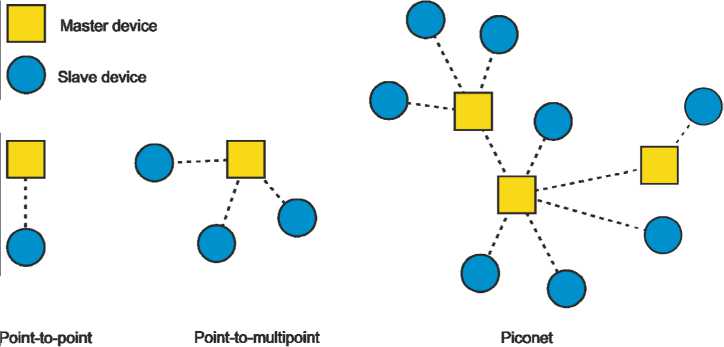
Fig. 4. Organization of a Bluetooth interface
face. The network includes the devices of two types, i.e. a wizard and a slave.
ESP-MDF is a tool for developing MESH applications based on ESP32 modules and ESP-MESH network protocol deployed “on top” of the Wi-Fi protocol [9].
The ESP-MESH network has self-organization and self-healing properties. These properties make the network deployment and maintenance completely autonomous. ESP devices, when uniting into a single network, form the “tree” network topology. Any of the network nodes can have both upstream and downstream connections, as opposed to a conventional Wi-Fi network. The throughput of up to 10 Mbps allows transmitting video data (for example, from surveillance cameras).
The protocol describes five types of nodes: a root node (the top node in the tree view), a child node (the node that is farther from the root node than the one to which it is connected), a parent node (the return child node), a sub-child node (accessed through the re-transition from the parent node to the child node), a brother node (connected to the same parent node).
The availability of Wi-Fi networks facilitates the development of building automation projects based on this technology.
Table 1 provides a comparison of ESP-MESH, Bluetooth Low Energy, ZigBee, and Thread interfaces [10].
Each of the technologies offers its own solutions for the wireless communication between devices in building and residential automation systems. The authors consider the ESP-MESH protocol as the most preferable option to solve the problem of remote electrical loads control in residential buildings.
This technology has the advantages of high bandwidth, data encryption, IP connectivity, which allows connecting to a local / wide area IP network without additional devices (Internet gateway). The power consumption per unit of time of the devices to be switched in Smart Home systems exceeds the consumption of the proposed wireless systems by an order of magnitude. Moreover, these devices are connected to the ~ 220 V network. In this case, it is advisable to give the switching device the function of a root node, which will allow connecting additional network elements and expand the coverage area in future. This solves the problem of subsequent modernization of the building automation systems.
Consider the classic point-to-multipoint Wi-Fi networking scheme, shown in Fig. 5. It represents one central node (access point) that is directly connected to all nodes. The AP performs several functions: transfer of data between it and nodes, relay from the external or internal IP network through the router. This network organization is characterized by a limited coverage area and the number of connected devices (determined by the access point capacity).
The ESP-MESH network is shown in Fig. 6.
With this network configuration, as described above, the root node (in our case, this load switching device) will connect to the home Wi-Fi access point, identify all the child nodes and end nodes, and assign its MAC address to each device. This network architecture allows connecting a large number of devices without overloading the Wi-Fi router.
After the selection of the data transfer interface and the protocol is completed, there appears another problem, i.e. the selection of the hardware to implement in commercially available products. Many manufacturers in the electronic component market today
Comparative characteristics of wireless interfaces
Table 1
|
Protocol |
ESP-MESH |
Bluetooth Low Energy1 |
ZigBee |
Thread |
|
Range |
2,4 GHz |
|||
|
Bandwidth |
< 10 Mbps |
< 2 Mbps 1 |
< 250 kbps |
|
|
Range |
< 200 m |
< 100 m |
||
|
The type and lifetime of the battery |
ААА / АA < 5 years |
CR2032 < 10 years |
||
|
Network topology |
Wire mesh |
“Point – point”, “Point – many points”, To picosat |
Wire mesh |
|
|
Security |
Password and certificate based authentication that supports all IP-based security standards |
Asymmetric encryption to generate and exchange keys, the connection of the pair of keys |
Optional network encryption and authentication via installed code |
Mandatory encryption; password based authentication with Datagram Transport Layer Security (DTLS) |
|
IP connectivity |
Integrated |
Installation of additional equipment is required |
IPv6 Addressing; installing an additional Converter from 802.15.4 to IP interface |
|
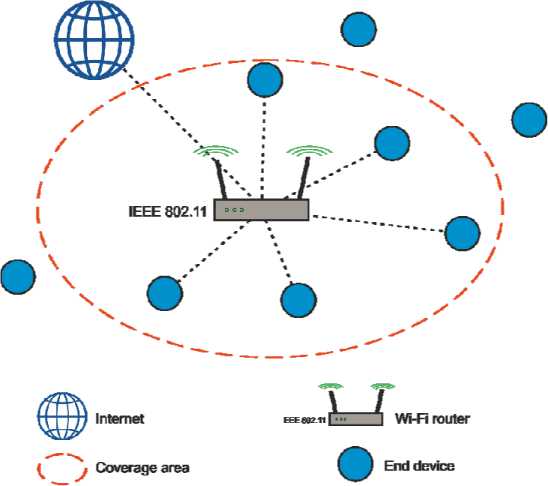
Fig. 5. Classic scheme of Wi-Fi network organization
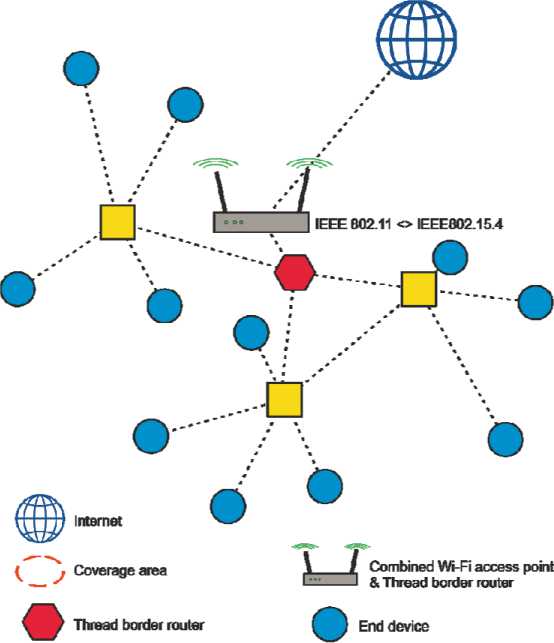
Fig. 6. ESP-MESH based network
support the development of the wireless technologies described above, including Texas Instruments, STMicroelectronics, Philips and many others. Howe ver, at the same time the supply of these components to Russia is challenging. One of the few solutions available for the developers in Russia is Espressif Sy s tems, an ESP modules manufacturer. An ESP32 -
WROOM module that supports Wi-Fi and Bluetooth Low Energy protocol stacks has been selected as an experimental sample.
The benefits of this solution include publicly available examples, which allow the developer to deploy the ESP-MESH network as soon as reasonably practicable.
Fig. 7 shows an ESP32- DEVKITC debug board [11].
As mentioned above, one of the most important tasks is to ensure the reliability of the wireless co m munication channel. The reliability of the mesh ne t work topology of is confirmed by the studies presen ted in Analytical- statistical model of MESH Network Survivability Evaluation .
This article presents an experiment, conducted on a mathematical model. The topology of the model is shown in Fig. 8 [12].
As a result of the analysis, the dependence of probability of connection establishment P on the number of closed transits c (termination of communication between network nodes) was obtained. The result is shown as a graph in Fig. 9.
The graph shows that if a large number of nodes (routers) fail, the communication will be restored. The amount of time required to recover the exchange depends on the number of routers that have left the network.
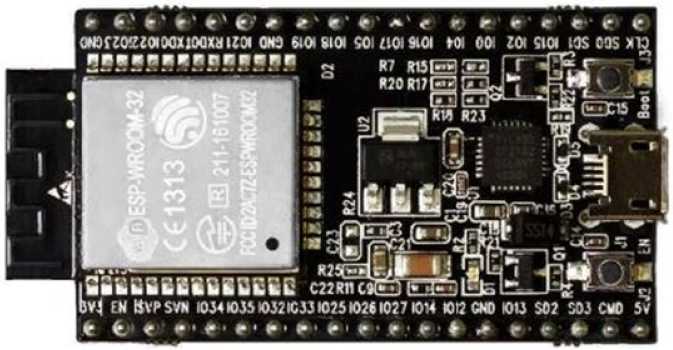
Fig. 7. ESP32-DEVKITC debug board
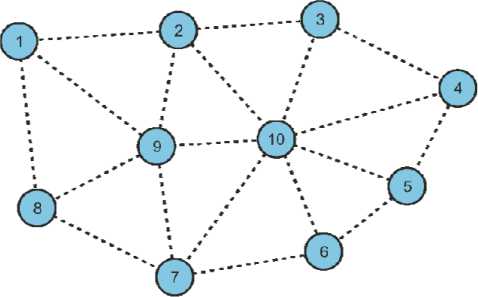
Fig. 8.MESH Network Survival Model Topology
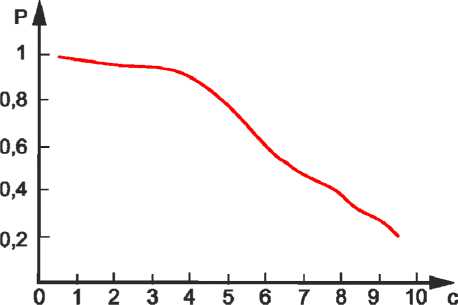
Fig. 9. Dependence of probability of connection establishment on the number of closed transits
Conclusion
Based on the review of modern wireless technologies in respect to the problem of the remote electric loads control in the residential buildings automation systems, the technology of self-organizing networks with cellular ESP-MESH topology has been selected. The main advantage of this technology is IP-addressing, which results in high integration with such common network technologies as Wi-Fi and Ethernet.
The proposed version allows solving problems in the design of residential buildings automation systems to ensure the reliabile communication by means of network topology self-organization, covering the areas exceeding the communication range of traditional point-to-point systems, while ensuring secure data transfer with encryption technologies provided by the ESP-MESH protocol developers.
Список литературы Electrical load control systems based on wireless data networks with self-organizing topology
- Uskov A.Yu., Tsimbol A.I., Monastyrenko V.I. [Method of Switching Electrical Loads of Residential Premises]. Elektrotekhnicheskie sistemy i kompleksy [Electrotechnical Systems and Complexes], 2019, no. 4 (45), pp. 29-34. (in Russ). DOI: 10.18503/2311-8318-2019-4(45)-29-34
- Valyavskiy Yu.P. [Electrical Installation in "Smart House"]. Energobezopasnost' v dokumentakh i faktakh [Energy Security in Documents and Facts], 2006, no. 4, pp. 28-37. (in Russ)
- Dyadyunov A.N., Kadyrbaeva A.R. [Defining Wireless LAN Propagation Zones]. Universum: tekhnicheskie nauki [Universum: Technical Science], 2017, no. 7 (40), pp. 18-23. (in Russ)
- Standard IEEE 802.15.4. Available at: http://www.ieee802.org/15/pub/TG4.html (accessed 24.12.2019).
- Guss S.V. [Private Wireless Mesh Networks]. Matematicheskie struktury i modelirovanie [Mathematical Structures and Modeling], 2016, no. 4 (40), pp. 102-115. (in Russ)
- About Z-Wave Technology. Available at: https://z-wavealliance.org/about_z-wave_technology/ (accessed 24.12.2019).
- Standard IEEE 802.15.1. Available at: http://www.ieee802.org/15/pub/TG1.html (accessed 24.12.2019).
- Grigor'ev V.A., Lagutenko O.I., Raspaev Yu.A. Sistemy i seti radiodostupa [Radio Access Systems and Networks]. Moscow, Eko-Trendz Publ., 2005. 384 p.
- Protocol ESP-MESH. Available at: https://docs.espressif.com/projects/esp-idf/en/latest/api-guides/mesh.html (accessed 24.12.2019).
- ZigBee VS Thread: Tekhnologii postroeniya besprovodnykh MESH-setey [ZigBee VS Thread: Wireless MESH technologies]. Available at: https://www.compel.ru/lib/92808 (accessed 24.12.2019).
- Development board ESP32-DEVKITC. Available at: https://docs.espressif.com/projects/esp-idf/en/ latest/hw-reference/get-started-devkitc-v2.html (accessed 24.12.2019).
- Tatarnikova T.M. [Analytical-statistical Model for Estimation of the Survival of Networks with MESH Topology]. Informatsionno-upravlyayushchie sistemy [Management Information Systems], 2017, no. 1 (86). pp. 17-22 (in Russ). DOI: 10.15217/issn1684-8853.2017.1.17

